When you first set out to build a brand – or if you hear that it’s important to have a brand, it can be quite confusing at first. 🤷🏻♀️
What does “a brand” mean, anyway?
For most entrepreneurs, their minds automatically go to the visuals – you know… logos and colors, et al.
And while these “pretty” elements are just the tip of the branding iceberg (There’s soooooooo much you need to establish first* – your brand personality, values, voice, etc…), the visuals are important.
So in this week’s blog post, I’m going to break down the visual side of branding: your brand identity system. I’ll outline the six different elements that you should consider assembling, so you can show up consistently and impactfully in this world!
Read (or watch the video below!) to get a picture of what your brand visuals actually are – on a very practical, tangible level.
Ready?
Ahhhhhhh… wait! I have to underscore this, first! 👇 (Then, I promise we’ll get to the pretty stuff! 😉)
*Keep in, as you read and learn… The design process really shouldn’t be completed until after you know what your brand stands for. Be sure to do the important foundational work first – or you may fall into the trap of having a pretty brand that doesn’t match who you are on the inside.
(And when that happens, it’s actually damaging… because you’ll quickly outgrow it – and confuse people in your market! Eeeek! 😬)
Okay, phew… Now that I got THAT off my chest, let’s assume that you’ve already done that foundational work. Let’s dive right into the six visual branding identity elements you will likely need as an entrepreneur…
Read on for the full details, or press play if you prefer to watch the video version:
Branding Element 1: Your Logo
If there is one element that wins the “brand popularity contest,” it’s the logo! 😉 Every new entrepreneur seems to yearn for a logo. I think it’s because there’s something about one that just helps us feel legit when we’re just getting started! (I get it!)
So what would make for a great logo – for your brand? One that looks good but is also functional? I have three tips to help you discern juuuuust that…
My number one tip with logos is this: Keep it simple.
Remember, your logo doesn’t have to communicate everything in your brand and your business. It simply needs to be a very clean, in-alignment design that you can use in many, many, different situations. We want a distinguishable mark that people will recognize – and one that works.
(It doesn’t have to be like a series of twelve icons or twelve symbols that represent every. last. thing. about your brand! I pinky-promise it doesn’t. If you were thinking in that vein, don’t doooooooooo it! Something complex will actually be so hard to use.)
When your logo is simple, it’s more likely that it will work well for you in many applications.
- It needs to look good on the web.
- It needs to look good in color – in black and white.
- It needs to look great when it’s very small (think: on a mobile phone or as the symbol for your app, for example).
- It needs to look good when very tall. (Think: On a sign or a billboard!)
- It needs to look good on a house, it needs to look good on a mouse.
Oops, sorry. Ignore that last one. That’s a different story! 🤣 I got carried away. But you get the point.
Second tip: Ideally, your logo will have some symbolism built in. The shapes used, the text style, the colors… we want them to be intentionally aligned with your brand values and personality – in addition to communicating what your business name is.
So if you are modern and future focused, then perhaps the typeface you’re using represents that. Likewise, if you are a more traditional, timeless feeling business and brand, then the typeface you use should convey that.
Third tip: There are different types of logos. Consider which might work best for you. (Pssst… It might be a text-only logo!)
Even though it may initially seem appealing to have a logo that is more complex and incorporates some type of objects (Of text-only logos, I often hear from entrepreneurs: “This isn’t a logo! It’s just text!”) …
… Sometimes a simple, text-only logo can be wildly effective. (I’m a fan, for sure!) Think about it… many of the biggest brands in the world have text as their logo. Canon. Fedex. Kleenex. Google, for goodness sake! It’s a completely 100% viable and effective way to go! So, don’t discount it.
Branding Element 2: Your Alternate Logos (aka “Alt Marks”)
Alt marks – or alt logos – are basically variations on your main logo. Having a couple of them gives you greater flexibility, as you can choose to use them when you’re not using your primary logo. (“Alt” is short for “alternative!”)
Here a few common ways that alt marks can be conceived and created:
Some can be similar to your logo – with the elements rearranged. For example, if you have a generally horizontal logo, you might want a version that is mostly vertical. So you can achieve that by stacking the elements in a different way – or maybe by re-sizing some of them to fit a bit differently.
Sometimes an alt mark is a small symbol – or a favicon. (That’s the little symbol that we see in tabs in our browsers when we’re on the internet!). So think… what could your little symbol be? Perhaps it’s just one *part* of your full logo – like the first initial? Or a recognizable shape?
You can also use alt marks that are like watermarks or stamps. These can literally look like a stamp… a circle or in a square just like a stamp would be – with similar elements like text or symbols inside. I personally really like having these – as they can easily be used as a design accent. They really add more variety and interest into your brand. And they are so versatile.
Branding Element 3: Your Brand Colors
The third element in your brand identity system is your brand’s color palette – and OhMyLanta!…
The process of choosing brand colors seem to elicit strong reactions from entrepreneurs. Some loooooove playing with colors. Some get *very* freaked out by this (seemingly-complex) choice.
(In fact, because I get soooo many questions and messages about colors, I have an entire vlog post and Youtube video training – aaaalllll about choosing them strategically. Check it out for the deep dive.)
But it IS really important to choose brand colors wisely, because they become a symbolic representation of our brands. Our subconscious minds do make associations when they encounter colors – so they say a LOT about who we are. And they ARE powerful.
Want some evidence? Think the “Golden Arches” or “Tiffany Blue,” for example! When we see those colors, we immediately associate them with those big brands, right?
(To be fair, as small business owners, we may never patent our colors like Tiffany did… but it definitely doesn’t hurt to create repetition by having a signature brand color palette! 😉)
In Brand New Brand (my signature course; more on that below), I teach entrepreneurs to start with a palette of five colors. (And this is what I’ve been doing with my 1:1 clients for years, as well.)
These two are used generally for text colors or backgrounds:
- a dark neutral – maybe it’s black or nearly black; and
- a light neutral – generally white or nearly white.
And then you also add…
- a primary brand color;
- an accent brand color; and
- a call to action color – which is going to contrast the rest of the palette, so that it visually jumps out.* 💥
Pro Tip: Be sure not to skip the accent color – even if you gravitate toward a palette that is more neutral or monochromatic. You’ll definitely need a color for buttons, links, and other things that you really want people to pay attention to! 🤓
And again, for more brand color tips and best practices (I KNOW you want ‘em!), head to this vlog post!
Okay, now on to elements 4 – 6!
Want to save this article for reference? Pin it to your business or branding boards!📌
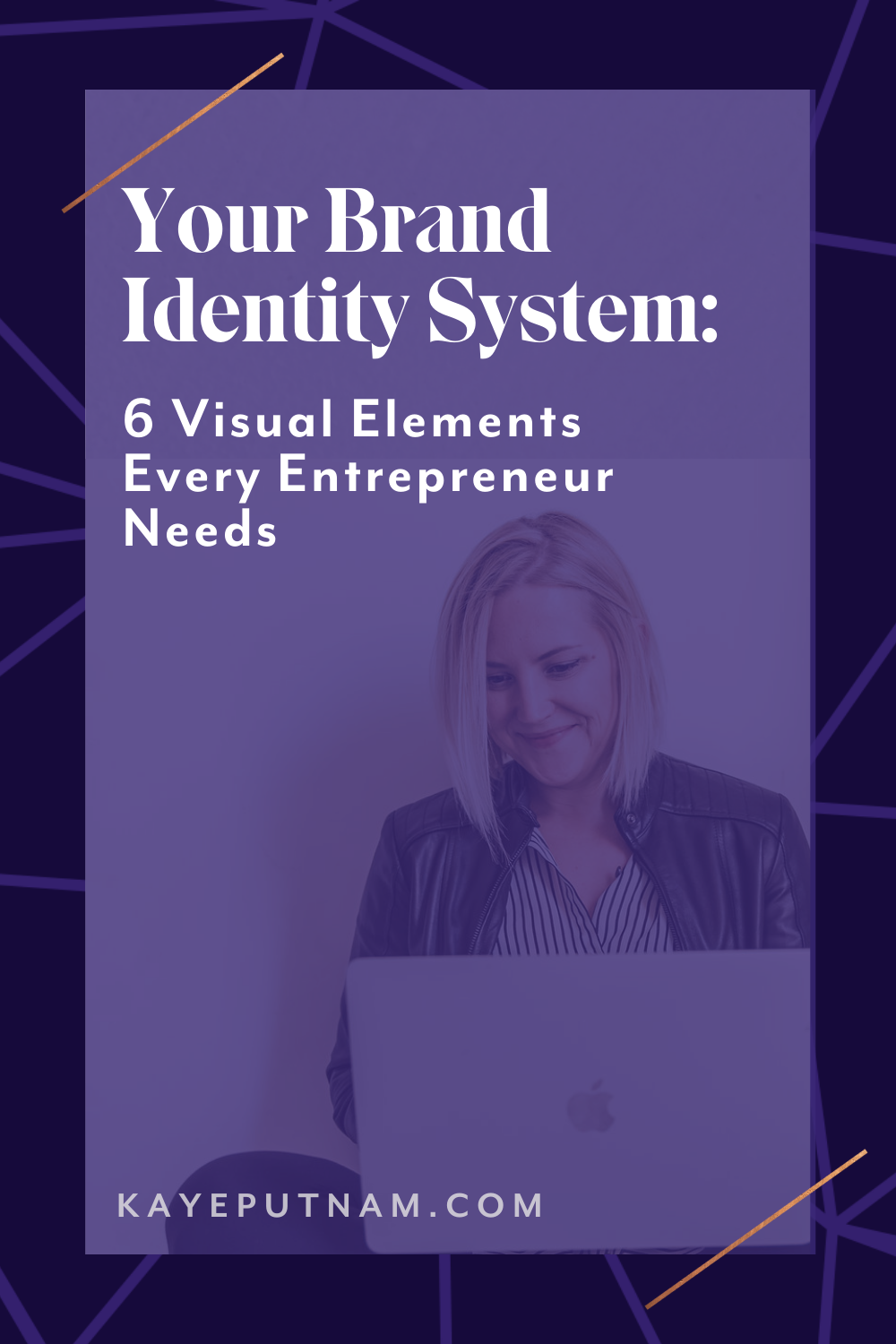
Pin this article to reference later! 📌
Branding Element 4: Your Fonts
Okay, on to fonts! I generally recommend a suite of no more than three fonts for entrepreneur brands – to keep things simple and consistent. You’ll need…
- a headline font,
- a body font; and
- a accent font (optional)
Note: Not everybody needs an accent font! It’s actually kind of trendy, and may go out of style at some point. But I use an accent font in my brand. It’s helpful for calling out specific words – and just to add a little bit more visual interest.
So, how do you choose the right font combo for your brand? Well, if you want to full 411 on fonts (and you don’t mind getting a liiiitttttle nerdy with me 🤓, check out this more full analysis of fonts and font psychology.
But, in terms of assembling your basic brand elements, keep these guidelines in mind:
Your body font will be used for the main blocks of text on your website, and in any other areas where sentences and paragraphs are called for. For this reason, it should be the most simple and readable of the suite.
Generally you’ll want to stick with a body font that is sans-serif, but that isn’t a hard and fast rule. There are websites that use serif fonts, but overwhelmingly people tend to like to read sans-serif fonts in longer paragraphs of text.
(Examples of sans serif fonts would be Arial, Montserrat, Open Sans, but head to the full fonts blog post if you want to learn more about these versatile, workhorse fonts – and about their fancy cousins, the Serif fonts! 😉)
With your headline font and your accent font, you have a bit more creative license to express yourself, since they won’t be used for large blocks of text. But they still need to be *very* easy to read.
(Word to the Wise: Be discerning here. If you love a font, but you’re not certain that it’s easy to read, just move on! You’ll find one that is both on-brand and legible – I promise!)
And for all of your typeface selections, you want them to be in alignment with who you are as a brand.
For example, you wouldn’t want to use a childish, round, soft-looking font – if you’re a high-powered attorney in New York City. (Obvious example, yes – but you’d be surprised how people make these types of branding faux pas on the regular!)
Likewise, if you are a Caregiver brand… a bold, in-your-face typeface would probably be out of alignment.
And if you are an Innocent brand… a fancy accent font with lots of twists and unique lettering would probably go against what you’re trying to convey.
(Pssst… New to the idea of the twelve brand archetypes like the Caregiver, Innocent, Royal, Hero, etc… ? You can learn about them – and take my brand personality quiz to determine yours – right here!)
Branding Element 5: Your Stylish “Extra Details”
Here’s where we start to get a little more advanced. Once you have the basics in place, you can broaden your scope a bit. You can incorporate signature textures, patterns, shapes, and / or other extra details.
I’ll use my own brand’s “extras” to illustrate.
I have two signature textures in my brand – a white marble texture and a copper metallic texture for accents. I use them quite often, and this creates that helpful and reassuring repetition. People know my work when they see it. Whether I’m creating a new product… a slidedeck… a new blog post or a new video… You’ll often see these textures used throughout – and my audience now associates them with me.
So think about your brand. Are there some signature textures or patterns that you can use in different places to help increase that recognition?
I also use some specific shapes in my brand – including metallic lines and squares. I’ve intentionally chosen those (instead of circles or more rounded elements, for example) to represent the stability of my Sage archetype. I want to evoke and reinforce the feelings of certainty and clarity that I’m helping my students and clients to achieve.
Other examples of “extra details” that you could incorporate include styled call-to-action buttons, image borders, illustrations, or icons. (So many possibilities here!)
By intentionally selecting these extras, you just make the decisions when defining your brand – and you don’t have to think about it anymore. (Nice, right? 😉)
No more hunting for the right little touches for whatever you’re creating at the moment. Instead, you just grab what you need from your “brand kit” and use ‘em!
Last thing about the “extras”… One of the best parts of having a clear, well-defined brand is that you can delegate creation to others when you’re ready – and things will still be consistent.
So, all of the brand identity system elements in this article fit into that equation.
But in my own brand, I think these “extras” really take this to the next level. I can easily work with multiple designers – and I’m not tied to one specific human that can help me be my brand. Equipped with all of the pre-selected pieces, any talented designer can simply put them together in new ways. And whatever they create still looks like me! (#winning!)
Branding Element 6: Your Photography & Images
The last main element of your brand identity system is photography and images. And there are really two categories of photos here – based on the source.
- Ideally, you’ll have some professional brand photos taken. If you’re an entrepreneur or you’re leveraging a personal brand, those may be shots of you. If you’re a product seller or retail business, the subject matter might be your products. (Many entrepreneurs do both – maker and products!)
I invest in pro shoots quite often – typically at least once per year. Custom brand photography is really accessible at all budgets, and becomes an Incredibly valuable asset that you can use again and again.
For all my best tips and strategies for getting the best results from your brand photo shoot, head to this comprehensive blog post!
- Alternately – or in addition – you can also curate a batch of on-brand stock images. I recommend taking some time to cull through and select a biiiiiig ol’ batch of them – before you need them! 🤓
By coralling them in one place, you’ll save loads of time later. Whenever you need an image for a presentation or for social media (or for anything!), you can shortcut that lengthy search process and simply mine your curated collection.
Plus, doing this ensures that you’re staying on brand with your images. You want to make sure that yours have similar tones, similar brightness, similar color themes showing up – so choosing them ahead of time keeps your choices more intentional.
But… What do you actually search for, to find the right images for you?
When considering the content of the photos, look for:
- people that look like they could be your ideal clients;
- situations that your ideal client aspires to or desires; and
- metaphors or symbolism that you want to incorporate into your brand.
For example, if you’re a personal stylist who specializes in working with urban women in their 40’s and 50’s, look for women in the right age range, and look for city settings. Look for photos of them looking confident and well-dressed, perhaps out enjoying life and work – and looking and feeling great.
And symbols to look for? You can include some literal ones – like stacks of high-quality garments and accessories.
You can also incorporate some more metaphorical ones*. For example, if you’re a Royal brand, perhaps you use images of Paris (synonymous with luxury and aspiration) or red carpets and velvet ropes (to evoke exclusivity).
(*Pssst… This is one of those places where having a deeeeeep understanding of those foundational pieces – like brand personality – really helps guide you. Remember to check out my Brand Personality Quiz to uncover your archetypes.)
Okay. Last thing about stock images… I want to share some of my favorite places to find stock images! A couple of my favorite free sites are…
If you want to find images that are less frequently used (so yours will feel more unique), and you can invest some money in your stock photo collection, try these faves of mine:
- Stocksy.com
- Istock.com
- Death to Stock Photo (These are very stylized, but awesome!)
- Creative Market (You can search on your own, or check out my curated photo collections. I have one for each of the 12 brand archetypes!)
Oh, and… (Ooops, sorry… THIS is the last thing about stock images!)… I also have a more in-depth Youtube video aaaaaall about how to get the best stock images for your brand. Check that out here!
So there you have them! … The six primary elements you’ll want to gather – for a complete and robust brand identity system.
It is really beautiful to see brands come together as you carefully select and curate all of these assets. But (You knew that ‘but’ was coming, right??? 😉) just remember not to skip the oh-so-critical foundational work first.
If you jump right to the end and just choose your visuals based on a hunch… you’ll probably be redoing this process again in a couple months.
Womp-womp.
And your brand just won’t be as good and as powerful as it could be.
If you want help with BOTH the foundational pieces AND the development of your on-brand visual identity – my Brand New Brand course could be just the ticket!
It’s my flagship course, and walks you through the process of building your brand from A to Z. Roughly one-fourth of the course is focused on exactly what I outlined in this article – your visual identity system. (Of course, the other three-quarters helps you define the foundational pieces first.)
Through Brand New Brand, you’ll gain *crystal brand clarity* as you build your brand from the ground up – defining, identifying, and creating all the pieces you need.
And (this is the best part!) you’ll also be documenting all of those decisions into a full-fledged brand book (template provided!). That’s the asset that allows you to then hand tasks off to your team, and/or to outside creatives like designers and copywriters – who can help you be your brand in the world.
Sound amazing? It truly is! >>> Check out Brand New Brand right here! <<<

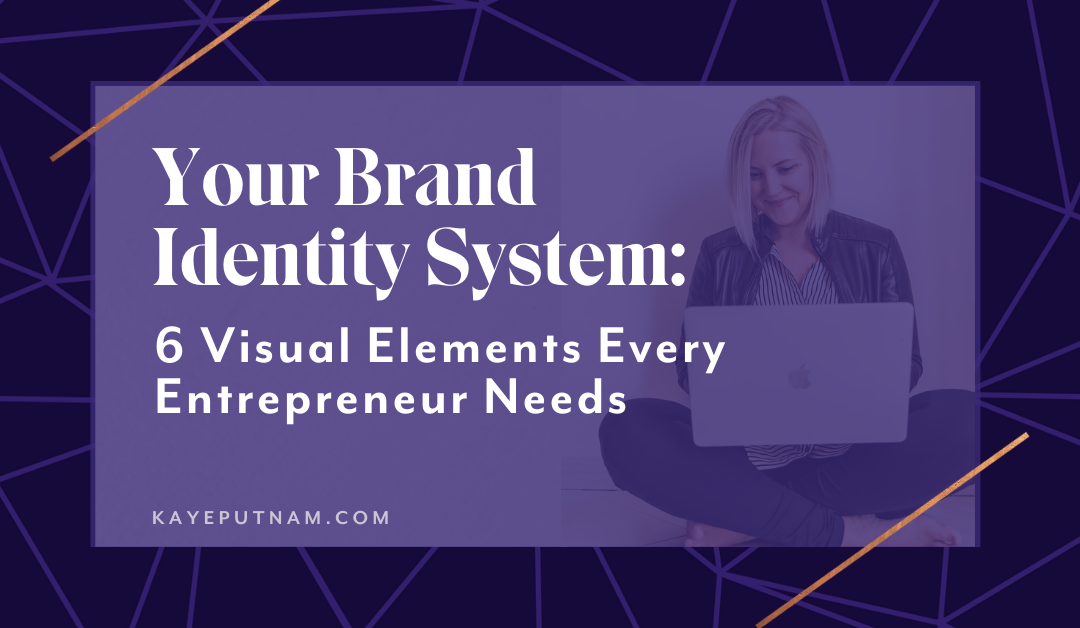
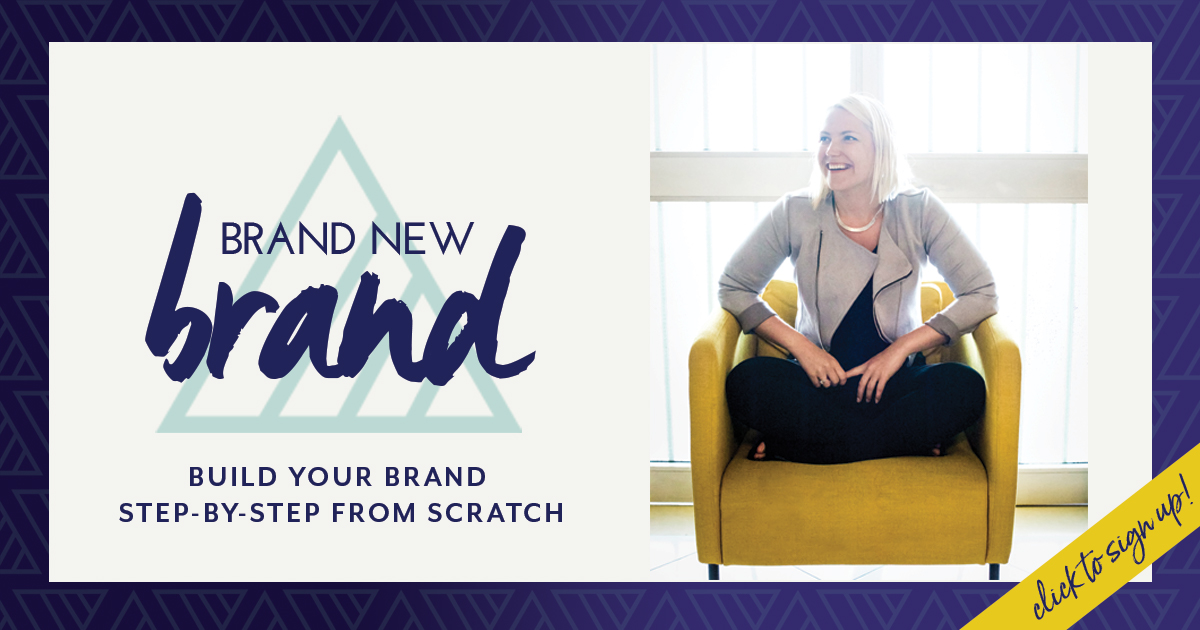
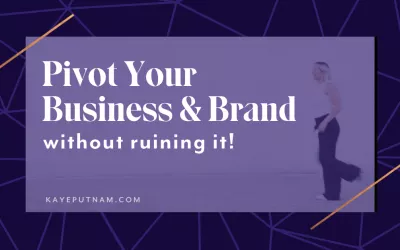
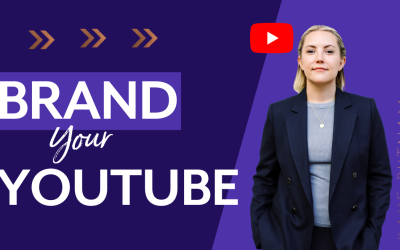

Hi Kaye, I came across your site, as recommended by Kathryn Porritt, of Business Bravery. She recommended doing your business personality quiz in one of her downloads that I was reading. And wow! What a treasure yin found in you, and in your information. Thank you for sharing all that you have, and are. You’re amazing. I’ve been learning lots from your articles, and quizzes, for my own business, and referring others to your quizzes, to help them too! Just wanted to say, job well done. I love your work. And thank you for the treasure that you are, and the gems that you share. It’s nice to know you’re here, and that I can with confidence, refer others on to you. 😊